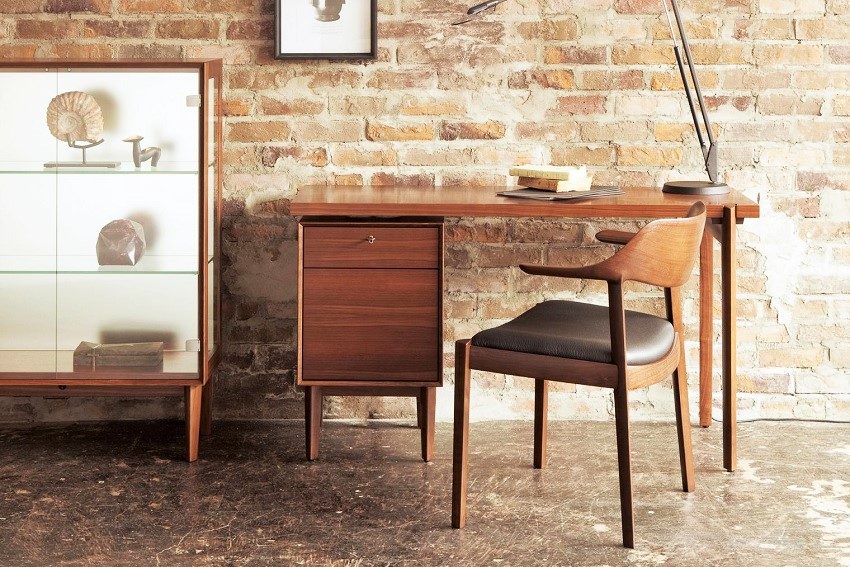On a wing and a chair: Japanese design in Adelaide

Kiyoshi Sadogawa of Japanese furniture maker Conde House shares the design secrets that inform his work, as one of his most striking creations makes its way to Adelaide.
On a Wednesday afternoon at Stirling’s Aptos Cruz Galleries, a small group of colleagues from a Hokkaido-based furniture company, Conde House, are gathered around a table from their collection. After a brief 24 hours in Adelaide, they have finished installing some of their most popular furniture in the upstairs gallery space ahead of an early flight to Auckland the following day where they will do the same again. Among the party is Kiyoshi Sadogawa, one of the company’s most highly regarded designers. Several of the objects in the room are his designs, including a chair that he considers his magnum opus, the Wing Chair.
“The good chair is a task one is never completely done with,” Hans Wegner, Danish designer of the iconic Wishbone Chair, once said, describing a chair fixation shared by many of the world’s leading furniture designers. A good chair, Sadogawa believes, should find beauty within function. A good chair also somehow pays homage to all the other good chairs that preceded it, yet is singular enough to take its own place around history’s table of good chairs. Sadogawa’s Wing Chair, released by Conde House in 2008, may well in time give its designer a seat at this table.
“When I decided to be a designer,” Sadogawa says through a colleague who translates for him, “I wanted to make something that would continue to be popular, something that did not belong to a moment in time.”
Like its maker – who has the dignified air of an owl – the Wing Chair holds a certain quiet elegance, with something in the upward slant of its arms that recalls a Brancusi Bird in Space. The soft curve of the seat repeats in the curve of the backrest. When you sit in it, it is pure comfort, giving the mind freedom to go elsewhere.
In October, Aptos Cruz became Adelaide’s only distributor of Conde House’s furniture, making it the second location in Australia (Apato in Melbourne’s Richmond is the first) where you can purchase a Wing Chair.
“A designer says to themselves, ‘I am going to design a new chair,” says Steve Ronayne, owner of Aptos Cruz. “Now, does the world need a new chair? There are already thousands upon thousands of chairs. But on the other hand, design is a continuum, a conversation. It represents our journey.”

Bringing the best of contemporary Japanese furniture into his gallery has been on Ronayne’s mind for some time. Ronayne’s wife, Pat, is Japanese and their son currently lives in Japan, so Aptos Cruz’s connection to the country goes deeper than a distant appreciation for Japanese design. In the 30 years he’s been in business, Ronayne has stocked many fine Japanese antiquities including chests, ceramics, prints and paintings, but, until now, more recent output from Japan has been noticeably absent on the shop floor.
“After the Second World War, Japan made, for a long time, furniture that was purely utilitarian,” Ronayne says, “and the soul and the heart was absent for a while. A chair was just a chair, not a reflection of a culture and a history and not a reflection of who the Japanese people are. In the 1970s and 1980s, as the economy grew, an appreciation for design began to return. Now, Japanese design is thriving again.”
Conde House, a company that turned 50 this year, has positioned itself at the forefront of this. Ronayne says that the company’s long commitment to craftsmanship and good design is what drew him to them. Conde House have brought in some of the world’s best contemporary furniture designers to contribute to their range, Sadogawa among them. Another designer visiting Adelaide is the company’s latest recruit, Jin Kuramoto, who believes the simplicity of Japanese design is what accounts for its wide appeal in times where life can seem anything but simple.
“In this country, you have the fork, the knife, the spoon, and many other kitchen tools that you hold in your hand,” says Kuramoto. “That is one way. In Japan, we have chopsticks. That is another way. Minimal and functional, that is what I like. I don’t like any decoration.
“I think that design should be determined by the nature of materials – the wood, or the fabric. The challenge for a designer is adding something unique, something new.”
Giving their designers access to the best materials to work with is central to Conde House’s success says its president, Tetsuya Fujita, who has been on the Aptos Cruz floor helping install furniture all day. Many of the woods are sourced from Hokkaido forests and, whenever possible, Japanese textiles and materials are used. In a time where retail is driven by a grinding consumerism, Conde House sings a different tune.
“It’s so restrained,” says Ronayne, a true admirer of his latest wares. “Everything is reduced to the simplest essence, and so, as you look at it over time, it only grows more pleasing. Furniture that will last until the next forest matures.”